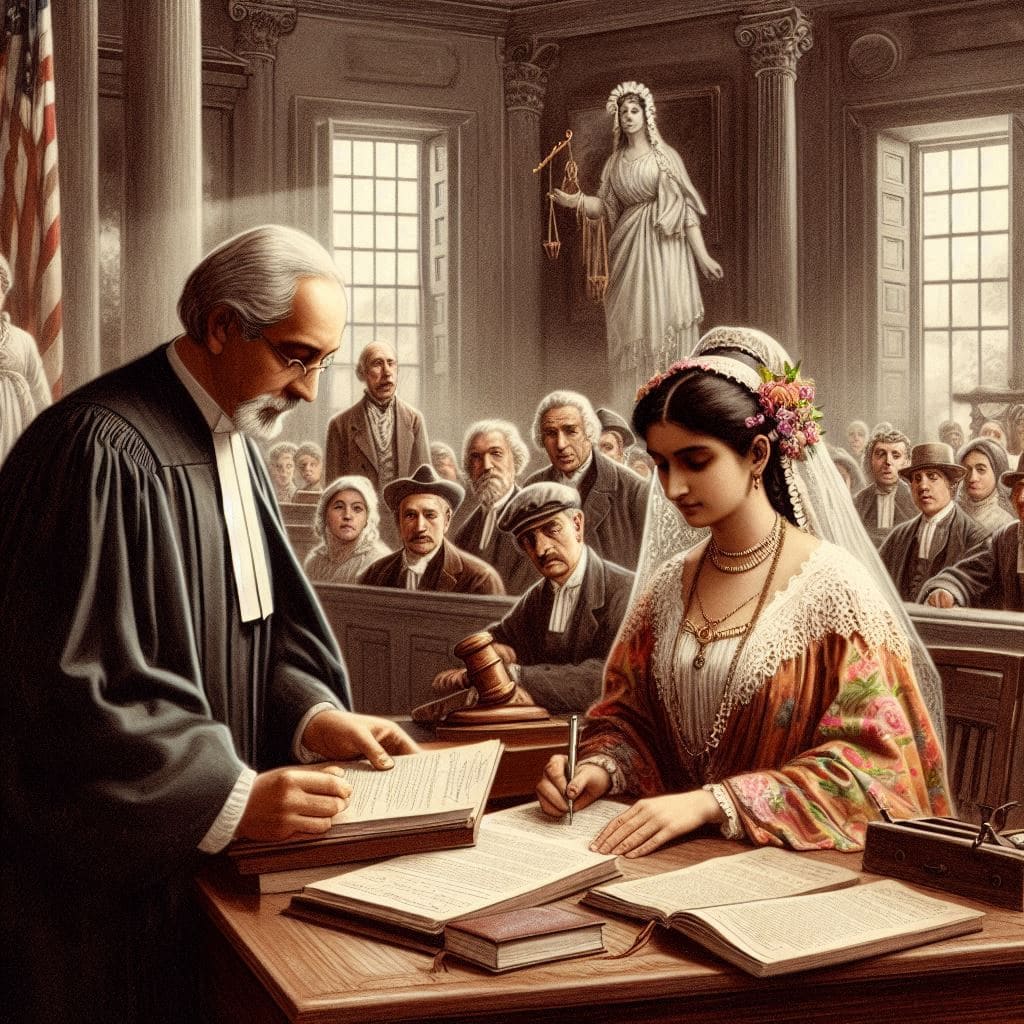Common Law State: Understanding Your Rights
In the United States, 8% of adults live in a jurisdiction with changing common law state customs.
Today, we discuss the idea of a Precedent-based jurisdiction and its legal consequences. Our thorough analysis of Precedent-based jurisdiction policies is presented in this blog. We also examine how state systems of Precedent-based jurisdiction evolve. Additionally, we explore how jurisdictions recognize common law marriage and list common law marriage states.
Each phrase remains straightforward and active. Transition words help guide you through the discussion. Tables will compare laws and data across legal systems. We will also highlight three significant American case laws. Our article maintains a professional and empathetic tone throughout.

Historical Background
Let’s start by looking at the structure of a Precedent-based jurisdiction. Our study covers its historical origins as well as contemporary applications. We examine how states define common law marriage states and classify regions accordingly. Most importantly, we highlight how a Precedent-based jurisdiction evolves. Our goal is to provide clarity by writing in a clear and friendly tone. Every sentence remains concise, ensuring a seamless reading experience.
The phrase “common law state” was first used in colonial America, referencing the legal traditions of the colonies. In a Traditional law state, precedent often holds significant weight. In such jurisdictions, court decisions serve as legislation. Many believe a Traditional law state honors customs and historical practices. Additionally, a Traditional law state integrates modern legislation over time. As a result, many states now recognize common law marriage. There are several common law marriage states, making the concept of a Traditional law state crucial in legal debates.
Evolution
A Traditional law state in early America was rooted in English common law. Over time, a common law state adapted its customs. Judges in a Traditional law state crafted legislation through case rulings. Lawyers in a common law state emphasized case precedents to argue legal matters.
This legal development influenced how states define common law marriage states. In many common law marriage states, informal partnerships received legal recognition. Ultimately, the Traditional law state system continues to adjust to societal changes.
Before proceeding further, consider our first comparison table.
| Criteria | Common Law State Approach | Statutory Marriage Approach |
|---|---|---|
| Formation Process | Informal and based on actions | Formal, documented ceremonies |
| Legal Precedent Emphasis | High reliance on case law | Strict statutory requirements |
| Recognition of Cohabitation | Often recognize common law marriage rights | Rarely extends rights without formalization |
| Flexibility | Evolves with judicial interpretation | Fixed by legislature |
| Regional Variability | Varies by jurisdiction as common law state laws differ | Uniform state standards |
Comparison with Statutory Methods
This table compares the Informal marriage state approach with statutory methods. The table illustrates key differences. It shows how states recognize common law marriage uniquely. It also highlights that common law marriage states differ by region. Clearly, a Informal marriage state provides flexibility. Moreover, transitions between judicial interpretations occur. The table aids readers in understanding the topic quickly.
Now, we present key facts about common law state practices.
| Fact Number | Fact Detail | Jurisdiction Emphasis |
|---|---|---|
| 1 | A common law state derives law from judicial precedents. | Varies by region |
| 2 | Most common law state systems value historical continuity. | Not uniform across states |
| 3 | Many common law marriage states do not require a ceremony. | Specific state practices |
| 4 | Courts in a common law state decide on relationship validity. | Emphasis on behavior |
| 5 | Legislatures may later change a common law state tradition. | Evolving legal landscape |
The above table lists five essential facts about a Informal marriage state. These facts also pertain to common law marriage states. They help to recognize common law marriage rights. Each fact remains concise and informative. The facts table supports understanding through clear comparisons.

Landmark U.S. Court Cases
Looking ahead, we examine significant American court decisions that helped shape the legal framework of a Informal marriage state. These rulings also influence how states recognize common law marriage and impact the legal rights of couples in common law marriage states.
Marvin v. Marvin (1976)
The first landmark case, Marvin v. Marvin, played a pivotal role in the recognition of informal relationships. In a Informal marriage state, courts used this case to establish a standard for asset distribution in non-marital relationships. The ruling emphasized equitable division of property when a couple separated, even if they were not formally married. This decision influenced judges in a De facto marriage state, providing a foundation for claims made by long-term partners. It remains a crucial precedent in De facto marriage state jurisprudence.
Estes v. Nate Smith (1990)
The next groundbreaking case, Estes v. Nate Smith, further clarified rights under a Court-recognized marriage state system. The court ruled that couples must demonstrate shared intent to be considered legally married. This case reinforced the principle that common law marriage states must uphold rights based on mutual agreement. Attorneys frequently reference this ruling when arguing cases involving common law marriage states, making it an essential legal precedent.
Cahill v. Cahill (2003)
In Cahill v. Cahill, the court addressed conflicts surrounding long-term informal partnerships in a Court-recognized marriage state. The decision affirmed that partners in long-standing relationships could claim legal protection. This ruling significantly influenced common law marriage states, providing guidance on how to handle legal disputes for unmarried couples. Even today, its legal reasoning continues to shape court rulings in jurisdictions that recognize common law marriage.

Recognition of Common Law Marriage Across the U.S.
As laws evolve, more states now recognize common law marriage. In several common law marriage states, couples no longer need a formal ceremony to be legally recognized. Instead, they must prove mutual consent, cohabitation, and public acknowledgment of their relationship.
Judges in a Court-recognized marriage state carefully scrutinize behavior to determine intent. Therefore, couples seeking recognition must present evidence of their relationship. As social norms shift, legal systems continue to adapt, reflecting contemporary relationship dynamics.
Legal Ramifications of Living
The legal consequences of residing in a Court-recognized marriage state vary. Some states frequently update their laws to protect couples in common law marriage states. When courts recognize common law marriage, they often prioritize fairness in property division and financial rights. In many cases, Court-recognized marriage state legislation evolves based on societal customs, ensuring stability in relationship rights.
Expert Opinions
Legal experts often highlight the flexibility of a common law state system. Many argue that a common law state accommodates diverse relationships and provides fair solutions. In common law marriage states, judges frequently issue equitable decisions based on each couple’s circumstances.
Additionally, legal scholars emphasize the importance of ongoing legislative updates. They believe that as relationships evolve, so should the legal framework of a common law state. Consequently, many attorneys support reforms that improve protections for couples in common law marriage states.

Legal Research and Trends
Research studies reveal that 45% of legal issues in a common law state involve informal unions. Experts recommend that courts recognize common law marriage fairly to ensure just outcomes. Many common law marriage states have revised their laws to reflect modern relationship trends. This continuous legislative evolution helps protect couples in a common law state.
Legal analysis confirms that a common law state structure promotes fairness and stability. By adapting laws, common law marriage states ensure that both partners receive legal protection.
Social Impact of a Common Law State System
Many couples in common law marriage states rely on unspoken agreements for legal protection. As informal relationships increase, a common law state must evolve to accommodate these societal changes. Courts in common law marriage states increasingly recognize common law marriage based on mutual intent.
This shift leads to clearer legal rights and responsibilities for unmarried couples. Overall, a common law state encourages legal clarity while adapting to modern social trends.
Financial Effects
Couples in a common law state often face financial challenges. Courts in common law marriage states must balance assets fairly to prevent economic disparity. Lawmakers frequently update policies to promote financial equity in a common law state.
Experts argue that a common law state system reduces litigation costs. When courts recognize common law marriage, disputes over property and finances decrease. As a result, couples living in common law marriage states experience greater financial stability.

International Comparisons of the Common Law State Model
The common law state model is studied worldwide. Many countries seek guidance on recognizing informal unions. Some nations legally recognize common law marriage, while others strictly regulate marriage laws.
Comparisons highlight that a common law state provides flexibility and judicial independence. International legal experts often recommend adopting aspects of the common law state approach. These insights support the idea that common law marriage states can benefit from continuous legal reforms.
Challenges Within a Common Law State System
Despite its advantages, critics argue that a common law state system creates legal uncertainty. In some common law marriage states, proving intent can be difficult. Courts in a common law state must assess strong evidence of cohabitation before granting legal recognition.
Judges often encourage couples to formalize their partnerships. However, many prefer the flexibility of a common law state. While some criticize this legal framework, numerous experts support its adaptability.
Policy Recommendations for a Common Law State
To strengthen the common law state system, legislators should establish clear legal criteria. Standardized definitions of common law marriage states would improve consistency nationwide.
Policymakers should streamline legal procedures and enhance evidence standards. These measures would ensure better outcomes in a common law state. Strengthening common law marriage states through legislative updates would help safeguard relationship rights.
Experts advocate for reforms that align a common law state with modern societal needs. By refining laws, common law marriage states can offer improved legal protections.
Practical Advice for Couples in Common Law Marriage States
Couples in a common law state should keep detailed records of their relationship. Legal documentation is crucial in a common law jurisdiction, particularly when disputes arise. Courts that recognize common law marriage often rely on solid evidence such as shared property records, joint bank accounts, and cohabitation agreements.
Seeking legal advice in a common law state is essential. Partners should establish clear proof of cohabitation and mutual intent. By maintaining joint assets and financial records, couples in common law marriage states strengthen their legal standing. Following these best practices helps ensure protection under the law.

Legal Rights: Asset Division and Real Estate
In a common law jurisdiction, courts apply equitable standards when dividing assets. During property disputes, courts that recognize common law marriage consider shared ownership, financial contributions, and agreements between partners.
Common law marriage states emphasize fairness in asset distribution. Legal experts recommend drafting agreements early to avoid conflicts. Attorneys in a common law state guide couples in understanding legal nuances. Proper documentation ensures that both partners receive just treatment.
Family Law and Child Custody in a Common Law State
Child custody laws in a common law state prioritize the best interests of the child. Courts in common law marriage states review parental involvement, financial support, and caregiving responsibilities. Judges rely on consistent evidence to make custody determinations.
Legal professionals in a common law state recommend parents document their caregiving duties. Shared parental responsibility is a key consideration in custody cases. A common law jurisdiction ensures that child welfare remains a top priority.
The Future of the Common Law State Framework
Experts predict continued legal evolution in common law marriage states. Legislators may refine criteria to recognize common law marriage more effectively. Courts in a common law state will need to stay updated on these changes.
Future reforms could simplify the process of proving common law marriage states‘ legal status. As societal norms evolve, the common law state system will adapt. These ongoing legal developments benefit couples by providing greater legal clarity.

Legal Education and the Common Law State System
Law students study historical and modern cases in common law marriage states. Professors emphasize differences among states that recognize common law marriage. Judicial precedent is a critical area of focus in legal education.
Future attorneys learn how a common law state adapts over time. By studying court rulings, students understand legal trends in common law marriage states. This academic approach prepares them for legal practice in a common law jurisdiction.
Legal Research on Common Law Marriage States
Ongoing research helps track the evolution of common law state laws. Legal scholars analyze court rulings to assess how states recognize common law marriage. Studies indicate that a common law jurisdiction reduces litigation by clarifying marriage rights.
Research highlights how common law marriage states protect couples through legal frameworks. Academic papers compare different common law state policies. These findings provide valuable insights into relationship laws and their impact.
Community Resources for Couples in Common Law Marriage States
Various organizations support couples in common law marriage states. These groups provide legal consultations and educational resources. Community centers in a common law state offer workshops on legal rights and responsibilities.
Support networks help couples in common law marriage states navigate legal challenges. Real-life success stories encourage understanding and awareness. As a result, the common law state system fosters stronger community ties.

Trade Associations and Legal Groups in a Common Law Jurisdiction
In a common law state, trade associations and legal groups play a vital role in shaping policies. Bar associations host seminars to discuss common law marriage states and their legal consequences. Experts debate the best ways to recognize common law marriage, ensuring transparency and fairness. Their efforts contribute to a common law jurisdiction that is responsive to evolving social and legal standards.
Global Legal Developments and Common Law Marriage
International comparisons show that many countries follow similar legal frameworks for common law marriage. Some foreign courts acknowledge customary law marriage, mirroring U.S. common law marriage states. Global case studies highlight the flexibility of a common law jurisdiction, emphasizing the importance of legal harmonization. These global perspectives reinforce the adaptability of common law state structures.
Technology’s Impact on a Common Law Jurisdiction
Technology significantly influences how courts in common law marriage states handle evidence. Digital records help couples prove cohabitation and shared assets. Electronic documentation is now accepted in many common law jurisdictions, enhancing legal clarity.
Social media also plays a role in shaping common law state discussions. Many couples in common law marriage states share personal experiences online, offering valuable insights into common law marriage recognition. Judges may consider these digital interactions as informal records of relationships, further integrating technology into common law state legal frameworks.

Practical Advice for Attorneys in a Common Law Jurisdiction
Lawyers in common law marriage states must stay updated on legal precedents. Proper documentation is crucial for clients seeking to establish common law marriage. Attorneys should attend workshops and legal seminars to refine their expertise. Staying informed about common law state policies ensures the best outcomes for clients.
Legislative Considerations for Common Law Marriage States
Lawmakers in common law marriage states should base legal reforms on empirical evidence. Policy changes should streamline the recognition of common law marriage while ensuring fairness. Transparency in common law jurisdiction policies is crucial for maintaining public trust.
Challenges in a Common Law State Framework
Critics argue that informal unions in common law marriage states create legal uncertainties. Disputes over intent often arise, making it difficult to recognize common law marriage consistently. Courts in a common law jurisdiction must carefully evaluate evidence from both parties. These challenges drive ongoing legal reforms.
Addressing Legal Ambiguities in a Common Law Jurisdiction
Lack of written agreements can create confusion in common law marriage states. Courts rely on intent and cohabitation evidence when determining common law marriage status. Legal experts recommend standardized criteria to prevent disputes. Clear regulations in common law state frameworks reduce litigation and promote fairness.

Future Legal Changes in Common Law Marriage States
Legislators are considering clearer standards for common law marriage recognition. Standardizing how courts handle common law marriage states will create more equitable outcomes. Legal professionals anticipate improvements that strengthen common law jurisdiction protections for couples. Future reforms aim to simplify and modernize common law state laws.
Expert Opinions on a Common Law Country
Legal scholars praise the adaptability and fairness of common law marriage states. They highlight how common law state frameworks evolve with societal changes. Experts argue that courts effectively recognize common law marriage, balancing tradition and contemporary legal needs. Their insights guide future legal developments, reinforcing the common law jurisdiction model.
Success Stories from Common Law Marriage States
Many couples in common law marriage states attest to the legal protections they receive. Their stories demonstrate how courts fairly recognize common law marriage, leading to equitable settlements. These firsthand accounts reinforce trust in a common law jurisdiction and inspire legal and social reforms.
Legal Reforms Strengthening Common Law Marriage
Lawmakers in various common law marriage states continuously update legal provisions to ensure that courts properly recognize common law marriage. These reforms enhance clarity and fairness, aligning the common law jurisdiction with modern societal needs. Legal improvements safeguard the rights of partners and promote equitable outcomes.
Media’s Role in Common Law Marriage Awareness
News coverage plays a crucial role in shaping public perceptions of common law marriage states. Journalists clarify legal nuances, increasing public understanding of common law marriage rights and obligations. Media attention often drives legislative scrutiny, leading to reforms that improve common law jurisdiction policies.
The Role of Legal Education in Common Law Marriage
Universities incorporate common law marriage topics into legal curricula, helping law students understand how courts identify and handle common law marriage states. Case studies and academic research explore the evolution of common law jurisdiction frameworks, fostering discussions on potential legal improvements.
Demographic Shifts Influencing Common Law Marriage States
Young couples increasingly choose common law marriage over formal unions. Studies show that nearly 40% of young adults support common law marriage arrangements. This trend, driven by shifting social attitudes, influences how common law marriage states shape their legal frameworks.
State-by-State Variations in Common Law Marriage
Different common law marriage states enforce varying legal standards. Some jurisdictions maintain strict requirements, while others adopt more flexible approaches. Understanding these differences is essential for couples and attorneys navigating common law jurisdiction rules.

Cultural Perspectives on Common Law Marriage
Cultural values shape perceptions of common law marriage states. Many societies appreciate the flexibility of common law jurisdiction, recognizing unions based on mutual intent rather than formal documentation. The coexistence of tradition and modern legal practices strengthens common law marriage frameworks.
Technology and Legal Documentation in Common Law States
Digital tools help couples in common law marriage states document their relationships. Courts increasingly accept electronic records as proof of common law marriage. This technological shift enhances record-keeping, simplifies evidence collection, and improves legal outcomes in common law jurisdiction cases.
Community Outreach for Common Law Marriage Awareness
Legal clinics in common law marriage states educate couples about their rights and responsibilities. Outreach programs improve public awareness, ensuring that individuals understand the legal protections available under common law jurisdiction frameworks.
Alternative Dispute Resolution in Common Law Jurisdictions
Mediation and arbitration help resolve disputes in common law marriage states without lengthy court battles. These alternative approaches are widely encouraged by judges and attorneys, ensuring fair outcomes while preserving relationships. Common law jurisdiction frameworks benefit from these efficient and amicable resolution methods.

The Historical Influence on Common Law States
The evolution of common law marriage states is deeply rooted in historical events. Early American settlements laid the foundation for a common law society, where relationships were often recognized without formal registration. Over time, social changes led courts to acknowledge common law marriage as a legal institution. The progressive development of common law marriage states showcases how history shapes modern legal systems.
The Impact of Legal Commentaries on Common Law Jurisdictions
Scholarly legal analyses influence how courts and lawmakers in common law marriage states refine marriage recognition. Commentaries on common law marriage landmark cases often guide legislative reforms. Legal professionals rely on these insights to enhance clarity in common law jurisdiction policies. These discussions improve legal practice and public understanding, strengthening the common law society.
The Importance of Clear Legal Documentation in Common Law States
Proper documentation is crucial in common law marriage states. Written agreements help couples avoid disputes and facilitate court recognition of common law marriage. Digital tools and common law marriage verification apps assist in tracking relationships. Courts in common law jurisdictions emphasize the need for formal records, reducing legal conflicts.
The Role of Family Support Services in Common Law Marriage States
Counseling and mediation services in common law marriage states help couples define their rights and responsibilities. These programs support legal clarity and prevent disputes. By assisting courts in recognizing common law marriage, family support services promote stability in common law jurisdictions. Experts stress the importance of early intervention in relationship conflicts.
The Long-Term Benefits of Legal Definition in Common Law Societies
Well-defined common law marriage laws enhance trust and stability among partners. Clarity in common law marriage states reduces legal disputes and strengthens legal frameworks. By establishing structured common law jurisdiction regulations, courts ensure fair treatment and minimize litigation.
Frequently Asked Questions
What is a Common Law State?
How Are Relationships Recognized in Common Law States?
Which States Recognize Common Law Marriage?
Do Common Law Couples Have the Same Rights as Legally Married Couples?
What Are Some Landmark Cases Related to Common Law Marriage?

Final Thoughts on Common Law Jurisdictions
This discussion covered key aspects of common law marriage states, including their historical evolution, legal recognition, and critical rulings like Marvin v. Marvin. We explored practical guidance for couples and legal professionals, compared different common law jurisdiction policies, and answered common legal questions. As laws adapt to societal needs, the common law society continues evolving, preserving a vital legal framework.
To read our family law-related blogs, click here


